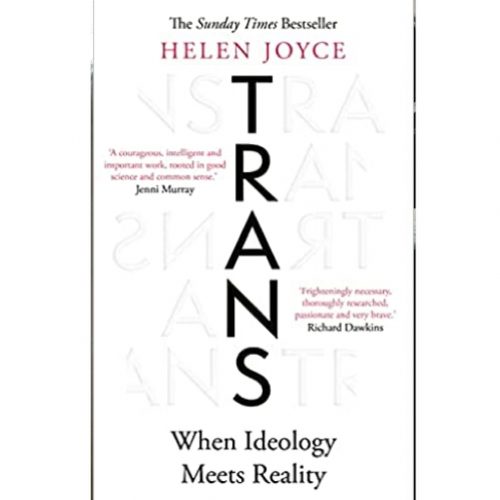Trans: When Ideology Meets Reality – by Helen Joyce
Oneworld Publications 2021 320 pages Hardback. ISBN 9780 8615 40495
FOR MANY OF US, the increasingly heated debate over trans rights has been something to observe from a distance with a mixture of bemusement and concern, with obscure acronyms such as TERF, TRA & GC being thrown around. What started as a seemingly innocuous proposal for reform to make it simpler for the tiny group of individuals who want to transition from one sex to another has become the focus of a toxic clash between trans rights activists and gender critical feminists.
We see the consequences of this all around us, with those who challenge the notion that self-declared gender identity should take precedence over biological sex being harassed and silenced. Even public figures such as the author JK Rowling have faced the threat of being “cancelled” for daring to speak out against the trans orthodoxy, whilst academics such as Professor Kathleen Stock of Sussex University have seen threats to their employment.
How did we end up here? How did we arrive at a situation where, within little more than a decade, public bodies, private companies, schools and universities, have all gone down the route of accepting self-declared gender identity, and using that as the basis for not just policy formation, but for access to what were once single-sex spaces? These are the issues explored in this important new book Trans: When Ideology Meets Reality by Helen Joyce, a professional journalist and Britain Editor at The Economist magazine.
It is certainly a timely publication. With the Scottish Government proposing new legislation to reform the Gender Recognition Act, this is an issue which is only going to achieve higher prominence in the public sphere.
Joyce sets out to provide an introduction to this issue for those who will not be familiar with all its aspects. Helpfully, she starts out by providing a history of transsexuality, going back 100 years to the origins of the notion that the person born into one sex could seek to transition into the other. Over time, and in particular with the politicisation of academia and medical research, the notion of “gender identity” was developed, distinct from biological sex, and it became accepted that individuals could adopt gender identities (which need not simply be binary) quite different from their biological reality.
This has led, perhaps most worryingly, to an explosion in the number of children, particularly teenage girls, developing gender dysphoria. These vulnerable young people are encouraged along a pathway of transition, many also being prescribed with puberty blockers. The early use of cross-sex hormones can cause irreversible physical damage to young people’s bodies. Joyce highlights the growing number of de-transitioners – those who at a young age, too early for them to fully understand the long-term consequences of their actions, made irreversible changes to their bodies that they now regret. And yet, clinicians push children down these routes as a consequence of political pressure.
Any doubts are silenced by the oft-repeated claim that gender dysphoric children face a choice of transition or suicide. There is an endlessly repeated figure that 48 per cent of young trans people have attempted suicide. So, if you are a parent, wouldn’t you prefer that your unhappy child went down the route of transition, rather than risk finding them dead?
The author states that this figure is highly dubious, at best, being based on the responses of 27 British trans people, as part of a larger survey promoted on LGBT websites. This is a tiny self-selecting sample, and yet it is the basis for a statement taken as gospel by too many people who should know better.
Many of the girls reporting with gender dysphoria have same-sex attraction, and would grow up as lesbians were they not pushed down the route of transition. It is perhaps not surprising, therefore, that so many of the gender critical feminists who are now speaking out against the radical trans agenda are themselves gay.
Where this book is at its most powerful is when it addresses how gender identity ideology erases women. Feminism has made great advances over recent decades, Joyce argues, and yet this progress is challenged by those who argue that anyone can define themselves as a woman simply as a matter of choice, thus ignoring biology. So we now have governments, companies, charity and media outlets talking of “people who menstruate”, “pregnant people”, “abortion-seekers” and “birthing parents”, where once they would simply have said “women”. Even the Scottish Government is now in on the act, according to recent reports banning the use of the word “mother” in official documents.
Female-only spaces matter for women. Women need to have privacy from men, in bathrooms, in changing rooms, and in prisons, not least for reasons of safety. That is not to argue, of course, that trans women are likely to be sex offenders, but there are undoubtedly male sex offenders who would see the opportunity of gender self-identification as a route to accessing women-only spaces.
Already we see this in the prison population. Of the 125 transgender prisoners known to be in English prisons in late 2017, 60 were trans women who had committed sexual offences, a share far higher than in the general male prison population. It seems highly likely that gender self-identification is providing these sexual predators with a loophole to allow them to access women’s spaces.
The book ends on a positive note, as Joyce details how British women are starting to fight back against the erosion of their rights. Court cases taken by individuals such as Maya Forstater, have been helpful in making it clear that gender critical views are protected by freedom of speech, and should be respected. The UK Government has already backed off from reforming the Gender Recognition Act to accept self-identification of gender, despite indicating originally that it was attracted to going down this route. Across the political spectrum, women politicians are speaking up, in the face of horrendous online abuse (and, in some cases, real threats of violence).
For anyone looking for an introduction to the debate around trans rights, this book is a must read. It sets this heated topic in a historical context, and provides useful material for all those who have to consider these issues. I hope that all MSPs (who, thanks to the organisation Sex Matters, have been sent copies) will take the time to read it, in particular the First Minister Nicola Sturgeon, who has said that women’s concerns about the reforms she proposes to the Gender Recognition Act are ‘not valid’.
If this publication provides a more informed debate than we might otherwise have had on this important topic, then Helen Joyce will have done us all a great service.
If you appreciated this article please share and follow us on Twitter here – and like and comment on facebook here.Help support ThinkScotland publishing these articles by making a donation here.








